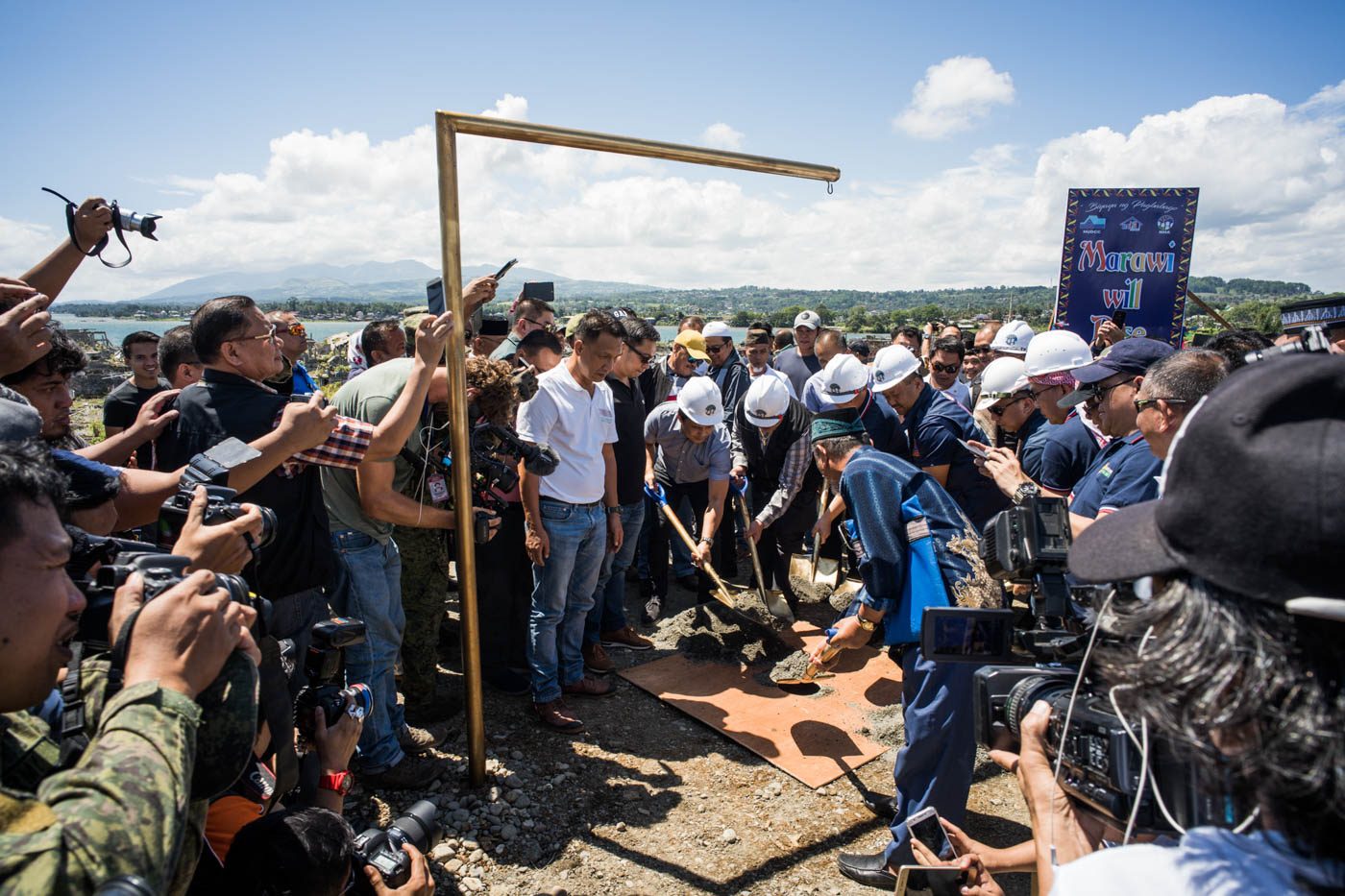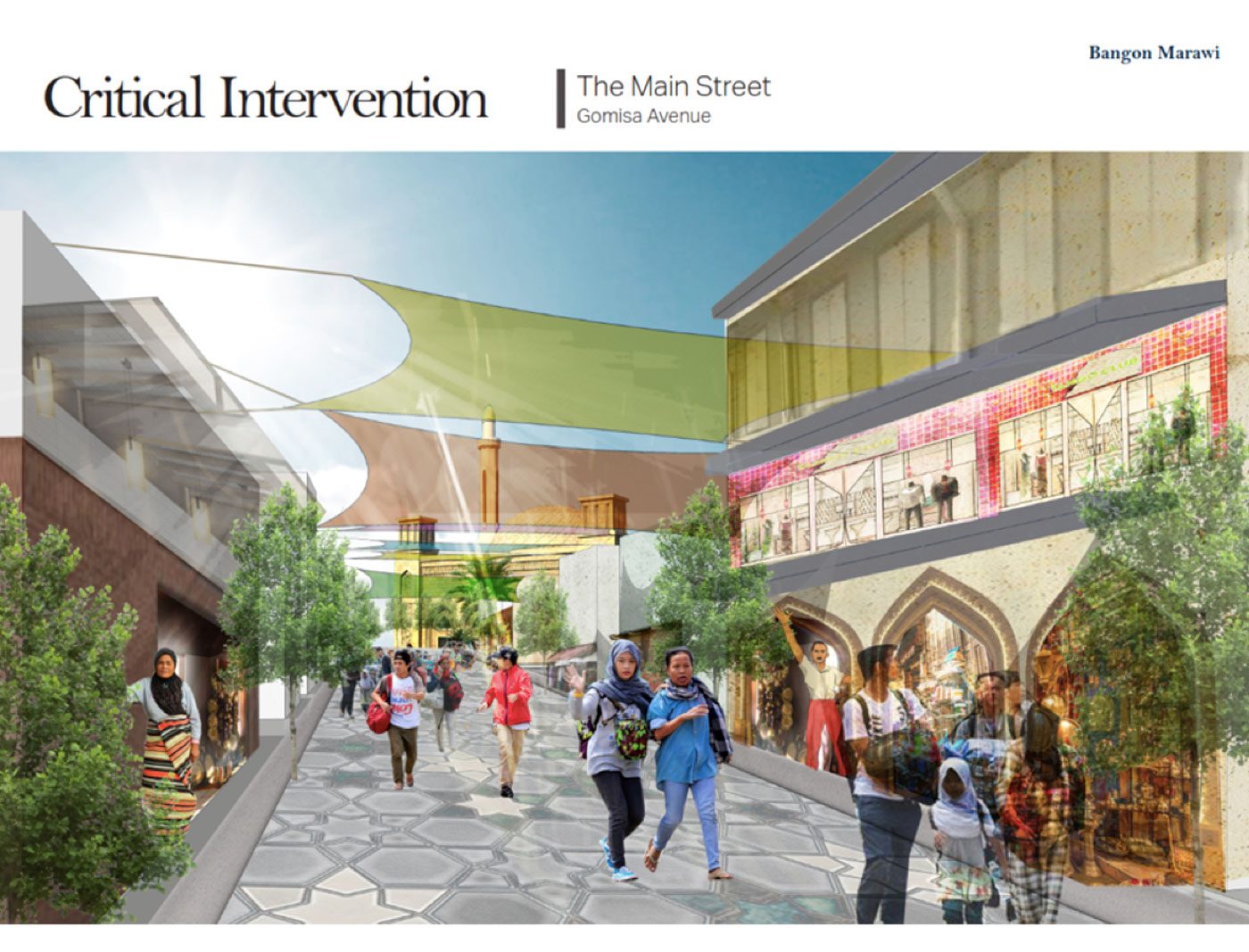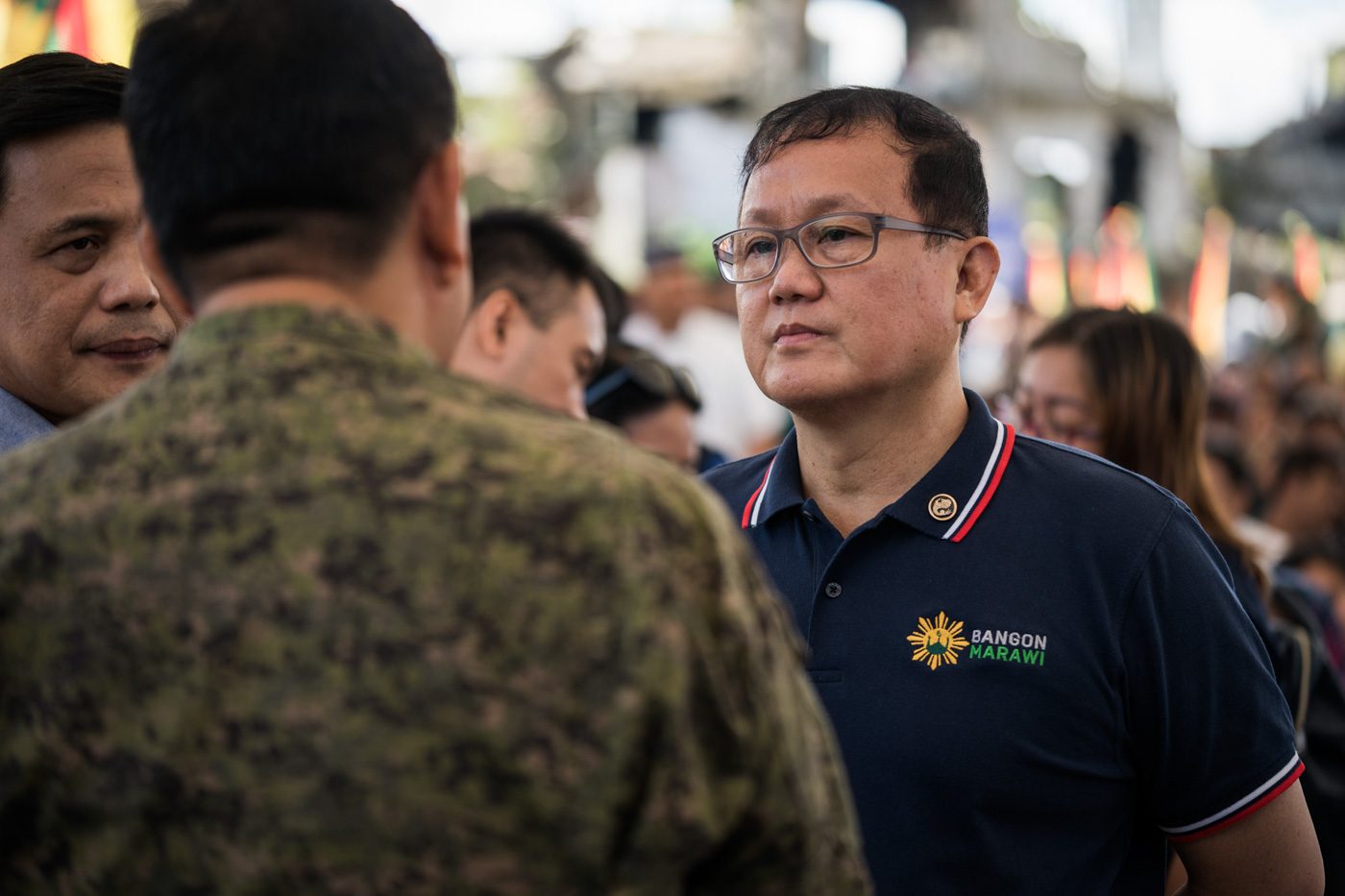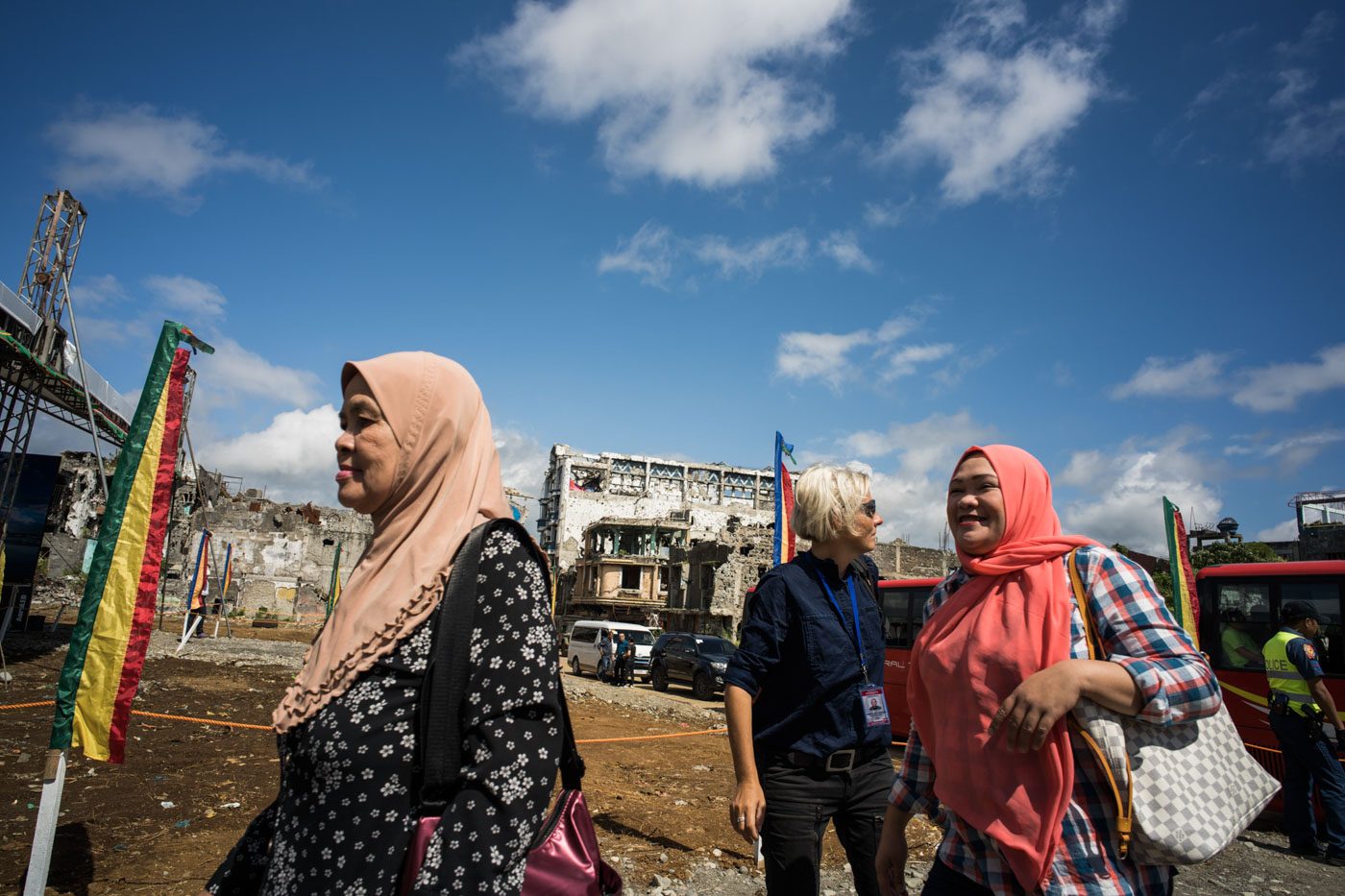SUMMARY
This is AI generated summarization, which may have errors. For context, always refer to the full article.

MANILA, Philippines – Marawi breathed a sigh of relief when, finally, a groundbreaking ceremony was held on Tuesday, October 30, marking the beginning of reconstruction of the 250-hectare swath left devastated by war.
It took more than a year after the city’s liberation from Maute Group and Abu Sayyaf forces for government to officially announce the start of rehabilitation.
For 12 months, ruins remained ruins. The sickle moon of Marawi’s mosques watched over darkened shells of what were once bright homes and busy thoroughfares. Residents of the so-called Most Affected Area (MMA) endured the “pain of uncertainty,” not knowing whether they would get their lives back, in the words of city mayor Majul Gandamra.
Up to the last minute, uncertainty also shrouded the groundbreaking ceremony itself.
After at least 4 postponements, the much-awaited event was slated for October 17, a date imbued with meaning as it marked the one year anniversary of the city’s liberation. President Rodrigo Duterte, however, could not make it that day, so it was moved to October 31.
But only 4 days before the ceremony, Malacañang told organizers Duterte again could not make it. So they scrambled to hold the ceremony a day earlier, on October 30.
Why did it take the national government a year to begin reconstruction? Rappler found that government agencies’ ill-founded insistence on using the joint venture model to lock down a developer for the rehabilitation was the biggest factor that led to unnecessary delays.
Malacañang issued an executive order to help Task Force Bangon Marawi (TFBM), the group of agencies in charge of rehabilitation, seal a joint venture agreement faster. EO 49 authorized the National Housing Authority (NHA), the procuring entity for Marawi rehabilitation, to be exempted from existing joint venture guidelines and be allowed to craft its own guidelines.
TFBM chairperson Eduardo del Rosario, chairman of the Housing and Urban Development Coordinating Council (HUDCC), told Rappler that it was the Bases Conversion and Development Authority (BCDA) that suggested a joint venture agreement for the Marawi rehabilitation.
“It was BCDA’s advice, being faster in procurement and implementation,” he said.
Months later, government finance experts and lawyers explained to Malacañang and TFBM that a joint venture agreement is not applicable to many aspects of the rehabilitation plan.
The task force initially stuck to its guns but conceded after a few months, as it reconsidered its strategy.
Here’s what happened.
Duterte champions ‘Swiss Challenge’
A joint venture agreement (JVA) was largely considered as a way to legally skirt the requirement that government must bid out projects to qualified contractors – a process that, in Del Rosario’s view, takes too long.
Three months after Del Rosario was named rehabilitation czar, Duterte publicly expressed aversion to public bidding.
“I will just tell COA to huwag na tayo mag-bidding. Puta, ‘pag mag-bidding ganoon din. Mas lalo nang matagal (Let’s not do bidding. When there is bidding, it’s the same. It will take longer),” Duterte said on January 27.
Bidding is required in our procurement law, save for special instances. When the government wants to carry out a project but lacks the capability to do it, it makes an open call for interested firms to bid for it. The firm that promises to fulfill the project specifications for the lowest price wins.
This is different from a JVA, Malacañang’s and TFBM’s preferred mode for Marawi rehabilitation.
In a JVA, the government and a private entity both shell out funds for a project expected to turn out a profit. They then share in the risks or rewards of the venture.
The government’s Public-Private Partnership (PPP) Center says under a JVA, the government and the private sector “jointly undertake an investment activity (which is eventually transferred to private sector under competitive market conditions).”
The Palace and TFBM wanted to choose a private entity to enter into a JVA for the rebuilding of Marawi structures. The private entity’s proposed plan and price would then be subjected to a Swiss Challenge – when the government allows other firms to present a proposal to challenge that of the original firm.
It was also Duterte who first voiced preference for a Swiss Challenge.
“Henceforth, all projects of the Philippines would be something like a Swiss Challenge…. I’m telling everybody. I’m telling Congress, COA, and the Supreme Court, that policy of lowest bid dragged us into corruption,” he said on January 27.
Del Rosario denied Duterte ever gave him instructions to pursue a JVA for the entire Marawi project.
“PRRD does not interfere in government transactions such as this,” he told Rappler in a message.
But only 9 days after Duterte expressed preference for a Swiss Challenge mode, he signed EO 49 exempting the NHA from JVA guidelines issued by the National Economic and Development Authority (NEDA) in 2005. A Swiss Challenge is an “inherent process in a JVA,” said Del Rosario.
The NHA would be the government agency that would sign contracts with private entities. The NHA is under Del Rosario’s HUDCC.
In the next two months, TFBM would hold talks with private firms forming the Bangon Marawi Consortium (BMC). The BMC was composed of 5 Chinese companies and 4 Filipino companies with experience in real estate development, construction, and power generation.
They were selected over 5 other interested entities. The task force, backed by Malacañang, was eager to sign a JVA with the consortium that would cover all aspects of rehabilitation.
The idea was to award all 22 components of Marawi rehabilitation as a package to just one private entity. This would speed up the rehabilitation as government would only be talking to one entity and the firms would be set up in a way that allowed easy coordination.
In early April, TFBM would disclose the companies behind BMC and spend the entire month consulting with Marawi residents and the local government on the consortium’s plan for the city.

Illustrations of the BMC’s plan for the new Marawi central hub showed tree-lined walkways in between gleaming glass buildings, green expanses surrounding a newly-built grand mosque, concrete promenades along Agus River, and even a resort-looking “cove retreat.”
These illustrations were supposed to have been presented to the public on May 4 so that firms interested in challenging the BMC as proponent for the rehabilitation would know what they were up against.
A few weeks were to be allotted for the government to accept competing proposals before they were to award the contract on May 30.
Unfortunately, this timeline never came to be as TFBM announced it was not yet done negotiating with BMC.
Opposition to joint venture
On May 16, NHA board members met to discuss the JVA. The NHA board is composed of department secretaries represented by undersecretaries or assistant secretaries. Executive Secretary Salvador Medialdea was represented by Deputy Executive Secretary for Legal Affairs Ryan Alvin Acosta.
During the meeting, former government corporate counsel Rudolf Jurado supposedly told the board that a JVA cannot be used for Marawi rehabilitation since the project is not a commercial venture meant to generate profit.
According to an official present in the meeting, it was explained that the scheme envisioned by Del Rosario did not fit the definition of a JVA.
Del Rosario thought that, in a JVA, the government would partner with a private entity who would then shell out all the funds to rebuild Marawi. Government would then only pay the private entity upon completion of the project.
In an August 17 press conference, Del Rosario recalled telling naysayers: “Bakit gusto pa natin iyong ibang modality, let’s say negotiated procurement na ang bayad tayo magpi-finance kaagad? Samantalang sa joint venture agreement, ang developer ang magpo-provide ng lahat ng pondo at babayaran natin sa huli using a buy-out option?”
(Why do you want another modality, let’s say negotiated procurement where we put up funds right away? While in a joint venture agreement, the developer provides the funds and we pay them at the end [of the process] using a buy-out option?)

Contrary to Del Rosario’s view, a JVA requires both the government and private entity to shell out funds at the start of the project. Del Rosario’s definition of JVA involves paying the private entity which, to Jurado, is plain and simple procurement.
Jurado had told the board that if they push through with the JVA, they could be charged for violating the procurement law. Del Rosario admitted he was told this.
“The other members told me that if we will do that, I might be charged in court…. But we have to do everything by the books. I don’t want to violate, but at the end of the day, it’s the people of Task Force Bangon Marawi who might get cases, maybe after the term of the President,” he said on August 17.
Acosta was supposedly shocked when told a JVA was not applicable to the project. He argued that going for a JVA is legal, citing Duterte’s EO 49.
Officials in the meeting invoked the President’s stance, saying Duterte was opposed to public bidding and wanted a Swiss Challenge.
But Jurado’s position was eventually backed by both the Department of Finance and the PPP Center.
“When the negotiation with the first developer was almost concluded, OGCC, PPP Center, and DOF raised concerns about the legality of JVA as a procurement modality considering that not all components in the MAA rehabilitation are income-generating and thus not all components may be covered by JVA,” HUDCC Undersecretary Falconi Millar told Rappler.
TFBM officials were understandably agitated since this roadblock popped up so late in the game, when they were about to finalize a deal with BMC.
Three days after the NHA board meeting, Duterte said in Cebu that “maybe I’ll fire the corporate [counsel] tomorrow.” A week later, he did fire Jurado, accusing him of “granting a franchise” to the Aurora Pacific Economic Zone (Apeco), which Jurado had denied.
Fighting for joint venture
For 4 months, from May to August, TFBM “fought hard” for a JVA, in the words of Millar.
He said they tried to reason that a JVA is applicable considering that the 22 rehabilitation components – ranging from road expansion to building a convention center – “the non-income generating components may be deemed to be essential components in the development and thus may be considered under the JVA.”
In other words, they insisted that the non-income generating aspects of the rehabilitation plan were critical to the income-generating aspects and so could, all together, be treated as a package covered by a JVA.
Then, in the midst of these long debates, on June 27, the 7-member Bangon Marawi Selection Committee (BMSC), the group in charge of choosing private entity partners, announced that BMC was disqualified for failing to meet the deadline for financial and legal requirements. BMC had also failed to meet an earlier deadline, May 25, for the requirements. This pushed back the task force’s timeline yet again.
Still, in the months that followed, Del Rosario insisted on a JVA, convinced it was the fastest way to implement rehabilitation.
But by August, he would concede that a JVA was not applicable to all rehabilitation components and agreed that it would only be done for the income-generating components. Thus, TFBM would unbundle the 22 components instead of treating them as a single package to be awarded to just one private entity.
“Since not all projects in the Marawi rehabilitation can be considered as profit-generating activity, then we have to separate that, and we are now doing the separation,” Del Rosario said on August 17.

Those components not considered income-generating could be awarded through either negotiated procurement or build-operate-transfer (BOT) arrangement, said the PPP Center. But the BOT mode could take 20 months so Del Rosario expressed preference for negotiated procurement.
Under the Republic Act 9184 or the Government Procurement Reform Act, negotiated procurement is a procurement method where the “procuring entity directly negotiates a contract with a technically, legally and financially capable supplier, contractor or consultant.” It doesn’t involve a Swiss Challenge.
Because negotiated procurement leaves room for a supplier to bloat the price of the contract, given the absence of bidding, this method can only be used under “extraordinary circumstances,” says the law.
Such circumstances include when “time is of the essence arising from natural or man-made calamities or other causes where immediate action is necessary to prevent damage to or loss of life or property, or to restore vital public services, infrastructure facilities and other public utilities.”
This would appear to cover the Marawi siege which caused widespread destruction of public utilities and infrastructure, disruption of public services, and agonizing months of waiting for displaced residents.
By August, BMSC was already negotiating with the second developer, Beijing-based Power Construction Corporation of China or PowerChina.
When talks with PowerChina were in the final stages, the PPP Center issued its recommendation that negotiated procurement would be the method of procurement for the non-income-generating Marawi rehabilitation components.
And so the NHA Board decided to start negotiated procurement for the first 5 rehabilitation components – debris clearing and management, road infrastructure with underground facilities, road expansion, acquisition of road right of way, and master development plan with feasibility study.
It began by awarding the P75-million contract for the first component (debris clearing and management) to FINMAT International Resources, Incorporated (FIRI), that supposedly had been PowerChina’s local partner.
‘New concept’
By the time Del Rosario took the stage at the October 30 groundbreaking ceremony, he announced the task force had come up with a “new concept.”
“Wala na tayong (We no longer have a) concept of total rehabilitation. What we will do is the local contractors will be included in the total rehabilitation. Seventy-five percent of the total rehabilitation will be done by local, if not all of it,” he said.
Eleven components would be opened to Mindanao firms and, that day, Del Rosario met with some of them.
Asked if PowerChina would still be involved, he said: “If they will qualify in other sub-projects in the convention center, why not? If their presentation is good.”
Of the 22 Marawi rehabilitation components, 14 will be procured through negotiated procurement while 8 may be implemented through a joint venture agreement, according to Millar.
It took TFBM some 5 months to concede that the BCDA’s suggested JVA mode for the entirety of Marawi rehabilitation is illegal. But even more time would have been saved if the JVA mode was ruled out in the first place for the non-income-generating components. Negotiated procurement for immediate needs, like debris clearing, could have begun much earlier.
The many meetings and discussions with potential developers, from May to October, were all premised on a JVA for the entire Marawi rehabilitation.
It’s also clear that TFBM officials’ insistence on a JVA was at least partly influenced by Duterte’s aversion to public bidding and that Del Rosario, ever the good soldier, fought tooth and nail for it.
Millar recalled “marathon meetings” while Del Rosario said he presented 3 times to “justify my case of having a joint venture agreement,” which led to “long debates.”
Del Rosario was convinced a JVA was the fastest way to do the rehabilitation and he was eager to get started because of the growing frustration of the Marawi residents and the general public. There was no way Marawi rehabilitation would become another Yolanda.
“How I wish iyong desire ng mga Maranaos na magsimula na ang rehabilitation, ang dami nang batikos sa amin, bakit daw napakabagal. Sabi ko nga kung ako lang masusunod, last May pa nagsimula ‘yan,” he said.
(How I wish we could fulfill the desire of the Maranaos to start the rehabilitation. There are so many criticisms against us, why is it taking so long. I said, if it were up to me, we would have started last May.)
“Kung minsan nahiya na akong humarap sa Cabinet at magbrief kay Presidente because of that delay (I am sometimes embarrassed to face the Cabinet to brief the President because of that delay). Pero (But) we have to do everything by the books,” he continued.
Military men don’t ‘debate’
Duterte often likes to say he appoints former military men to Cabinet positions because of their discipline, action-orientedness, and professionalism. But there’s one characteristic in particular that he values – obedience.
Calling military personnel “utility boys,” Duterte contrasted them to argumentantive civilians in government whom he blamed for slowing down the bureaucracy.
“Susmaryosep, debatihin ka pa (Jesus, they even debate with you). That’s what they do. They debate with you and day after tomorrow, nandiyan na naman, daldal naman, daldal, daldal, daldal (they’re there again, talking, talking, talking),” he said in a Palace event on October 9.
In a speech in Cagayan de Oro on October 31, Duterte praised Del Rosario, a retired military general, for the pace of Marawi rehabilitation.
“Would the project in Marawi have been done so quickly if I hadn’t assigned Del Rosario? He’s a military man who was also assigned in Davao,” said Duterte.
But it was Del Rosario’s well-intentioned determination to stick with the Palace-backed JVA that, in the end, contributed to delays in the awarding of contracts for Marawi rehabilitation.
Del Rosario eventually gave in to the insistence of civilian members of the bureaucracy – finance officials and lawyers – that shortcuts could not be made at the expense of laws, however cumbersome they may be. – Rappler.com
Add a comment
How does this make you feel?
There are no comments yet. Add your comment to start the conversation.